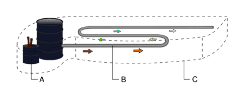Day 49: Sustainably Heating Your Home Part II—Fuel Burning Devices
Dear Student,
There are many ways of burning solid fuel in the home. Of course, however, fire is dangerous and emits smoke that can be damage to health, so correct procedures for burning should be followed no matter how you choose to burn a fire in the home.
Fireplaces, the most common indoor fire burning devices, are charming but inefficient—especially the old style big open fire or brazier in a large grate. They have several downsides… The majority of the heat goes directly up the chimney. They also generally require daily cleaning and they burn a lot of wood.
To prevent chimney fires, chimneys connected to fireplaces need cleaning every several years as soot builds up inside. And a fireplace blocked by soot or a bird nest will back up large amounts of smoke quickly into your living space.
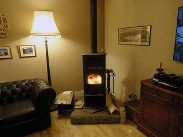 Safe and reliable, wood-burning stoves can be much more heat efficient than fireplaces and require less wood. They also burn the fuel at higher temperatures, creating less soot and creosote (chemicals given off by burning wood). These stoves can be stand-alone or inserted into the wall like a traditional fireplace. Air vents act like bellows, drawing air into the bottom of the fire for a fast, clean burn, and they can be closed to damp down the fire when it’s warm enough or when you’re going to bed. Their only real downside is needing a heat shield to protect the walls behind if situated close to or in a wall.
Safe and reliable, wood-burning stoves can be much more heat efficient than fireplaces and require less wood. They also burn the fuel at higher temperatures, creating less soot and creosote (chemicals given off by burning wood). These stoves can be stand-alone or inserted into the wall like a traditional fireplace. Air vents act like bellows, drawing air into the bottom of the fire for a fast, clean burn, and they can be closed to damp down the fire when it’s warm enough or when you’re going to bed. Their only real downside is needing a heat shield to protect the walls behind if situated close to or in a wall.
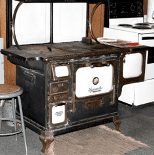 Old-fashioned, dual-purpose wood-burning cooking and heating stoves last for decades and even centuries (see image). They typically have an oven, a plate heater underneath, and multiple cooking surfaces on top for pots and pans. They are not digitally operated and a little practice is needed to figure out how much heat is needed from one.
Old-fashioned, dual-purpose wood-burning cooking and heating stoves last for decades and even centuries (see image). They typically have an oven, a plate heater underneath, and multiple cooking surfaces on top for pots and pans. They are not digitally operated and a little practice is needed to figure out how much heat is needed from one.
Recycled paper bricks can be burned in stoves with other woods, as can dry nut shells and corn husks.
Cleaning Your Chimney
Fireplaces and stoves that use the chimney of a previously existing fireplace will require cleaning now and again to prevent issues. You can do this yourself or have a a professional do it for you. It’s a messy job… The fireplace must be sealed completely and a long-handled, strong-bristled brush is pushed down from the chimney pot on top of your house. The soot falls into the fireplace or stove and is shoveled or vacuumed out (with an industrial vacuum cleaner). Many modern stoves have a flue pipe that exits through the wall of the house and is easier to clean from the outside of the house.
Super-Efficient Ancient Stove And Heater Designs
The easiest, most efficient, and most sustainable method of fueling or heating your home is using ancient stove designs, including:
- Rocket stoves, used for cooking with little firewood
- Masonry oven (kachelofen or steinofens, often called brick or stone oven), ancient heating stoves that store heat all day
- Rocket mass heaters, are a combination of the above
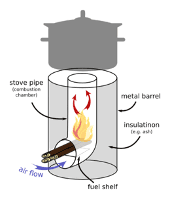 Rocket stoves are a low fuel consuming stove that use sticks and small branches that you can find around your yard or scrap wood from lumber making. Rocket stoves burn at high temperatures, as the fire in the fuel shelf draws air into the stove pipe and acts as a bellows. All the heat of the fire is directed at the bottom of the pot or pan on the top of the stove or burn plate it sits on. High burning temperatures makes for a clean burn with less pollutants. The fire may be started with paper wads pushed in with the kindling or with a small butane torch.
Rocket stoves are a low fuel consuming stove that use sticks and small branches that you can find around your yard or scrap wood from lumber making. Rocket stoves burn at high temperatures, as the fire in the fuel shelf draws air into the stove pipe and acts as a bellows. All the heat of the fire is directed at the bottom of the pot or pan on the top of the stove or burn plate it sits on. High burning temperatures makes for a clean burn with less pollutants. The fire may be started with paper wads pushed in with the kindling or with a small butane torch.
The origin of today’s masonry ovens can be found in German kachelofen or steinofens. Working models of these radiant space heaters are still used in Germany today after 800 years of use. Often tiled for a pleasing appearance and for ease of cleaning the outside, these large storage heaters are built from brick or stone but nowadays can be made from thermal concrete.
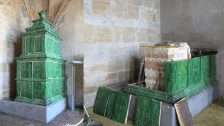 Masonry ovens have a burn chamber similar to a rocket stove (4 to 6 inches in diameter), but instead of directing the heat to a cooking area, the heat from a is run through narrow pipes or baffles winding through the mass of brick or concrete, maximizing the surface area for heat absorption. The firebox may be situated outside the home and lit there or lit in the room itself. The fire burns intensely for about 15 minutes before burning out. The heat is absorbed by the thermal mass of the brick before being vented outside as cool exhaust. Once the fire is out, the exhaust is dampened or turned off to prevent heat escaping outside the house. The heat is stored in the thermal mass and slowly released out during the day. The surface of these stoves doesn’t get hot due to the nature of the slowly releasing heat, and are rarely too hot to touch.
Masonry ovens have a burn chamber similar to a rocket stove (4 to 6 inches in diameter), but instead of directing the heat to a cooking area, the heat from a is run through narrow pipes or baffles winding through the mass of brick or concrete, maximizing the surface area for heat absorption. The firebox may be situated outside the home and lit there or lit in the room itself. The fire burns intensely for about 15 minutes before burning out. The heat is absorbed by the thermal mass of the brick before being vented outside as cool exhaust. Once the fire is out, the exhaust is dampened or turned off to prevent heat escaping outside the house. The heat is stored in the thermal mass and slowly released out during the day. The surface of these stoves doesn’t get hot due to the nature of the slowly releasing heat, and are rarely too hot to touch.
Rocket mass heaters are a combination of rocket stoves and mass heaters (masonry stoves). In these, the heat from the fire box heats a burn plat and the exhaust heat is then run through a series of baffles of winding pipes that are embedded in a thermal mass of concrete or adobe in the form of benches. These benches absorb the heat in its thermal mass before venting the exhaust gasses outside the home. Steady heat is radiated out throughout the day, and the benches can be used as heated seating or beds while heating the room. Variations of these ideas can be used to heat water by plumbing in a water line through the mass heater.
Fueling Your Stove Sustainably
Burning big logs of wood in open fireplaces is wasteful, and while conventional wood-burning stoves are better, they don’t store heat, with much lost through the chimney.
Using small sticks about the diameter of a man’s thumb or less in rocket stoves or masonry ovens is much more sustainable and captures nearly all the heat generated, using a fraction of the wood.
Replacing Your Woodlot With A Small Coppice
Coppicing is the cutting of certain trees at ground height; pollarding is the cutting of trees at head height. These practices encourage a massive regrowth of branches or whips. These whips make for ideal rocket mass and masonry oven fuel. The practice works on many types of trees, including willows.
The huge regrowth rate is due to a well-established root mass, which immediately drives the fast regrowth of branches. In a couple of years, you can re-harvest these branches for use as fuel, rather than having to wait 10 to 20 years to get large logs for burning.
Much greater amounts of fuel are produced per unit of area using these methods and allows you to reduce or eliminate the need for a large woodlot by replacing it with a small area for coppiced trees.

